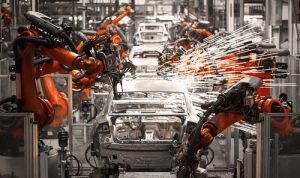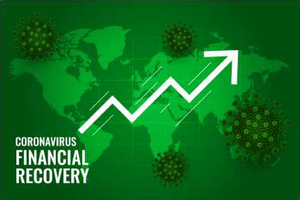 Signs of recovery are beginning to appear in the world car sales. 2.14 million cars were sold in China this May, which is expected to exceed sales volume of the same month last year for the 2 consecutive months. The Chinese government has introduced subsidies for new car purchase. 1.11 million of new cars were sold in the U.S in May, which is 30.1% decrease compared to a year earlier. The level of decrease improved from 46.6% down in April, and the sales volume recovered to 1 million units for the first time in 3 months. As for Europe in May, sales record is 168,148 & 20,247 units in Germany & the U.K. respectively, 49.5% & 89% down compared to the same month last year (both improved from 61.1 % & 97.3% down in April).
Signs of recovery are beginning to appear in the world car sales. 2.14 million cars were sold in China this May, which is expected to exceed sales volume of the same month last year for the 2 consecutive months. The Chinese government has introduced subsidies for new car purchase. 1.11 million of new cars were sold in the U.S in May, which is 30.1% decrease compared to a year earlier. The level of decrease improved from 46.6% down in April, and the sales volume recovered to 1 million units for the first time in 3 months. As for Europe in May, sales record is 168,148 & 20,247 units in Germany & the U.K. respectively, 49.5% & 89% down compared to the same month last year (both improved from 61.1 % & 97.3% down in April).
On the other hand, the annual operating rate of the world’s automobile factories in 2020 is expected to fall to the lowest level of 49%. Throughout the 2010s, the operating rate of automobile factories around the world remained at around 70%. Due to the spread of new coronavirus infection, the production adjustment of automobiles has expanded to China, Europe, and North America since the middle of March. The scale of production reduction reached 5 million units, which is equivalent to about 80% of normal production.
The number of newly registered passenger cars in Europe in the first quarter of 2020 decreased by 25.6% compared to the same month a year ago, but the newly registered electric vehicles in January 2020 doubled in number. According to European Alternative Fuels Observatory (EAFO), The ratio of the number of electric vehicles in the newly registered cars is still 4%. However, it has pointed out that the rate of increase in the number of newly registered electric vehicles will exceed 100% in the first quarter of 2020.
The US Department of Labor ‘s May employment statistics released on June 5th show the unemployment rate of 13.3%. That is 1.4% improvement from 14.7% unemployment rate in April. Market expected the unemployment ratio would be 20% or more, so we can recognize the economic activity is now resuming. Employees in Non-agricultural sector increased by 2.5 million people in number from the previous month. Market had forecast to the contrary that the number would fall about 8 million. In any case, the current situation is improving faster than expected. 24.91 million people received unemployment insurance benefits at the peak of April. In the last week of May, the number reduced by 3.43 million, down to 21.48 million. Trump administration is providing companies with 660 billion dollars in total, on condition that they retain current employment. Since the fund supply is also applied to the re-employment of companies that substitute the salary of employees, it is considered that it encouraged the early return of temporary dismissal on the assumption of early return to work. The ratio of layoff to the total unemployment is 80% in April, and 70% in May.
The U.S. Energy Information Administration (EIA) reports the average US retail price for regular gasoline on June 1st was $1.97 per gallon (about 3.8 liters), 11% up from the lowest price in four years and two months in late April. By May 20th, economic activity resumed in all 50 states, automobile transportation will increase, and expectations for bottoming out of the economy is spreading. Demand recovery in the US, which is the largest consumer of gasoline, can be a factor of the rise in crude oil prices. Given the broad automobile industry, the world’s economic recovery would be faster than expected. Also, human life and vitality might be stronger than we think.
Toyota Motor Corporation announced on June 6th that it will establish a joint venture with five major Chinese automobile manufacturers to develop fuel cells and will supply the fuel cell vehicle (FCV) system developed by Toyota to major Chinese automobiles in 2022.
Meanwhile, on May 29th, Volkswagen announced it will invest 50% to the parent company of the Chinese electric vehicle (EV) joint venture. The Chinese government aims to become the leader of the next generation vehicles by pairing Chinese State-owned enterprises with Volkswagen that sells vehicles most in China for their EV technology, and with Toyota Motor Corporation selling 2nd most in China market for their FCV technology, and by having State-owned enterprises acquire such technologies.
 Amid the global economic slowdown, Chinese government-led infrastructure investment is active. Crude steel production in April remained at the same level as the previous year. China imports 1 billion tons of iron ore a year, which accounts for two-thirds of the sea trade. Iron ore import in April increased by about 20% from the same month of the previous year to meet the demand of active crude steel production. Singapore/Thailand exports remain strong. Singapore’s April export amount (excluding oil) increased by 9.7% compared to the same month a year earlier. That is an increase for 3 consecutive months. The main factor is in the pharmaceutical, 2.7 times increase from the previous month, especially to Japan which is 9.6 times, and to the European Union (EU) which is 5.7 times, showing astonishing growth in exports to developed countries and regions. Exports of food items to the United States also increased 3.2 times, increasing by 66% overall. Thailand also marked an increase in pharmaceuticals and food export. In April, exports of rice and fruits, which are the main export items, increased by 23% and 3%, respectively, and exports of fish, wheat, fodder etc. were all increased compared to the previous year. Exports of medical equipment and pharmaceuticals also grew by 9 to 13%, boosting the total export value (2.1% up). A scenario is starting in which the two major economies of the United States and China slowly start to move, revitalizing the economies of the surrounding countries and recovering the world economy.
Amid the global economic slowdown, Chinese government-led infrastructure investment is active. Crude steel production in April remained at the same level as the previous year. China imports 1 billion tons of iron ore a year, which accounts for two-thirds of the sea trade. Iron ore import in April increased by about 20% from the same month of the previous year to meet the demand of active crude steel production. Singapore/Thailand exports remain strong. Singapore’s April export amount (excluding oil) increased by 9.7% compared to the same month a year earlier. That is an increase for 3 consecutive months. The main factor is in the pharmaceutical, 2.7 times increase from the previous month, especially to Japan which is 9.6 times, and to the European Union (EU) which is 5.7 times, showing astonishing growth in exports to developed countries and regions. Exports of food items to the United States also increased 3.2 times, increasing by 66% overall. Thailand also marked an increase in pharmaceuticals and food export. In April, exports of rice and fruits, which are the main export items, increased by 23% and 3%, respectively, and exports of fish, wheat, fodder etc. were all increased compared to the previous year. Exports of medical equipment and pharmaceuticals also grew by 9 to 13%, boosting the total export value (2.1% up). A scenario is starting in which the two major economies of the United States and China slowly start to move, revitalizing the economies of the surrounding countries and recovering the world economy.
The price of brand-new container in China at the end of May is $2,000 per 20F. Factory inventory of brand-new container is 1,059,957 TEU (Dry: 1,013,310 TEU, Reefer: 46,647 TEU). That is $50 down in unit price per 20F and 2.4% down in stock. The operating ratio of major container leasing companies remains high at 95-96%. But delay in reconstruction of the supply chain drops container operating ratio. As a result, willingness for investment on newly built containers declines. Shipping lines are inclined to own containers, which will reduce lease opportunity. Due to depot inventory increase, competition intensifies among leasing companies. Major leasing companies are likely to suffer from cost increase as well as lowered revenue ratio, falling down to negative cycle. As such, it is expected that major leasing companies have difficulty in securing investment money.
 I was often asked in Japan from Europeans and Americans visiting Japan, “Why are you wearing a mask?” Recently people in their own countries are wearing masks, so I suppose they will no more ask that kind of question from now. There are various colors and shapes, so masks may become a part of fashion. By the way, Japan has missed a good opportunity to start semester in September just like schools in Europe and U.S. In Japan classes start in April, but it couldn’t this year due to COVID-19. In case this situation prolongs in May and June, that will lead to decline in students’ academic performance who enrolled this April. In order to avoid it, September start was once a subject of discussion, but emergency declaration was lifted in mid-May, and this topic fizzled out in the end.
I was often asked in Japan from Europeans and Americans visiting Japan, “Why are you wearing a mask?” Recently people in their own countries are wearing masks, so I suppose they will no more ask that kind of question from now. There are various colors and shapes, so masks may become a part of fashion. By the way, Japan has missed a good opportunity to start semester in September just like schools in Europe and U.S. In Japan classes start in April, but it couldn’t this year due to COVID-19. In case this situation prolongs in May and June, that will lead to decline in students’ academic performance who enrolled this April. In order to avoid it, September start was once a subject of discussion, but emergency declaration was lifted in mid-May, and this topic fizzled out in the end.
It comes with pain when we try to change things, but I think it is sometimes necessary to tackle to change oneself or the current system. New energy comes out there. No matter what you like or dislike, New Normal will swallow us into a big swell with the new era. If that is the case, why not take it ahead and convert it into your own energy. I believe it must make your life interesting. Of course, society will also improve. I want to take on the challenge with courage.